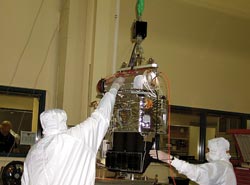We know carbon dioxide is all around, but pinpointing its location and quantity was the focus of a recent NASA mission. Unfortunately, a satellite with instrumentation onboard to monitor carbon throughout the Earth’s atmosphere crashed into the ocean shortly after launch.
Developed by Hamilton Sundstrand’s Energy, Space & Defense facility in Pomona, Calif., the Orbiting Carbon Observatory was a $270 million spacecraft with an instrument that included a telescope and three high-resolution grating spectrometers. The telescope was designed to capture sunlight reflected off the Earth’s surface and to break it up into its constituent colors with a diffraction grating. The color spectrum would then have been analyzed to determine how much carbon dioxide (CO2) and molecular oxygen were present. The plan was to compare measurements taken close to Earth with those taken from ground stations, tall towers, aircraft and other satellites, including NASA’s Aqua satellite.

The Orbiting Carbon Observatory had quite the photonic payload aboard when, upon launch, it crashed into the ocean near Antarctica. Courtesy of Jet Propulsion Lab.
Forecasting CO2 levels
The mission was led by NASA’s Jet Propulsion Laboratory in conjunction with Orbital Sciences Corp. of Dulles, Va., and Hamilton Sundstrand Sensor Systems. It’s known that a good deal of CO2 is trapped by thick, dense forests – but with those forests changing, scientists wonder what will happen to the CO2. Measurements gathered on this mission would have enabled scientists to forecast changes in CO2 levels at various locations and potentially would have helped determine what effect these alterations would have on climate change.
A similar satellite, called the Greenhouse Gases Observing Satellite, was launched successfully in January by the Japan Aerospace Exploration Agency.